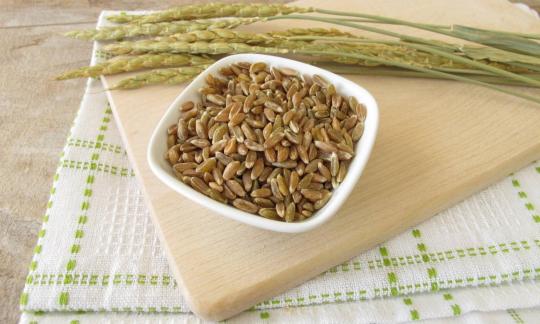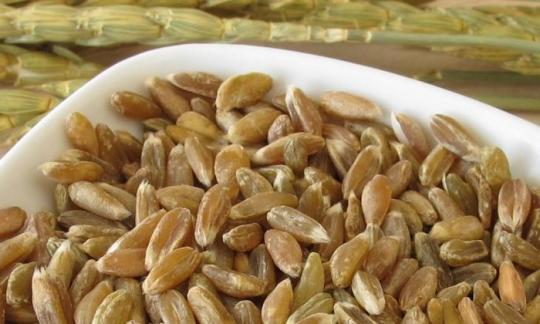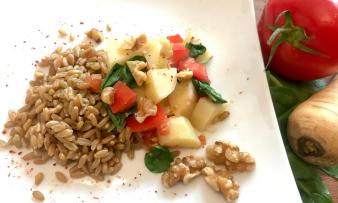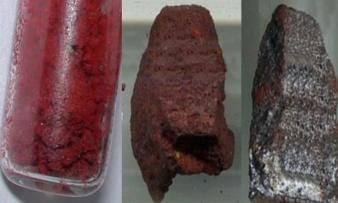Table of contents
Green spelt ( Triticum aestivum ssp. spelta), also known as green grain, is the half-ripe spelt grain that is then dried and kiln-dried - so it is never raw. Organic?
Using green spelt in the kitchen:
Drying not only makes the half-ripe spelt grain durable and hard, but also gives the characteristic olive-green grain its typically intense aroma - smoky and slightly nutty. Is green spelt raw? This process causes it to lose its raw food status. In addition to the whole grains, green spelt is also available as green spelt groats, semolina, flakes and flour. In this article we focus on green spelt grains.
Green spelt should be thoroughly rinsed before preparation. Then boil it with twice the amount of water for around 10 minutes over a high heat, before covering it and leaving it to swell on a low heat for around 30-40 minutes. If you let green spelt grains soak in cold water overnight, you can reduce the cooking time to around 10-15 minutes. You can use the cooked grains as a side dish similar to rice, couscous, bulgur, kamut or millet, or use them in all kinds of dishes.
Green grains are popular for soups, patties and dumplings. But the green grains are also great for "rice-free" risotto, salads (e.g. with chickpeas, dried tomatoes, capers and red onions), casseroles and stews (e.g. with various root vegetables such as carrots, parsnips, celeriac and potatoes). Also try the recipe for parsnip and spinach vegetables with walnuts and green spelt. You can also use them to make vegetarian or vegan fillings for cabbage rolls or cannelloni. Also recommended are broccoli and green spelt pans and green spelt pilaf with spinach, chickpeas, tomatoes and sumac.
In addition to salt andpepper, many other spices and herbs can be used to refine green spelt dishes, such as curry powder, paprika powder, chili powder, allspice, ginger, parsley, thyme and coriander.
Recipe for vegan chili sin carne with green spelt:
Ingredients (for 6 people): 250 g green spelt (organic), 500 ml vegetable stock, 2 onions, 2 cloves of garlic, 2 red bell peppers, 2 carrots, 8-9 tomatoes, 250 g cooked kidney beans, 250 gcooked corn kernels, 1 teaspoon salt, 2 teaspoons paprika powder, ½ teaspoon pepper, ½ teaspoon ground cumin, ¼ teaspoon chili powder.
Preparation: Rinse the green spelt and cook in boiling vegetable stock for approx. 30-40 minutes. Meanwhile, peel and finely chop the onions and garlic cloves. Wash and dice the sweet peppers, carrots and tomatoes. Fry the onions and garlic in a frying pan. Add the green spelt and fry briefly. Add the sweet peppers and carrots and cook for a few minutes. Add the tomatoes and add a little water. Add the kidney beans and corn and season with salt, paprika powder, pepper, cumin and chili powder. Simmer the whole thing for approx. 30 minutes.
Vegan green spelt recipes (whole grains) can be found under the note: " Recipes that have the most of this ingredient ".
| Not only vegans or vegetarians should read this: Vegans often eat unhealthily. Avoidable nutritional errors. |
Shopping - where to buy green spelt?
Green spelt can be found in some supermarkets (e.g. Migros, Spar, Rewe, Edeka, Hofer), organic supermarkets (e.g. Denn's Biomarkt, Alnatura) and health food stores - mostly in organic quality. Other supermarkets (e.g. Coop, Denner, Volg, Aldi, Lidl, Billa) rarely or never have green spelt on offer.
Green spelt is vegan, but not raw. Organic quality is common, as spelt and its products are widely available. High-quality green spelt grains can be recognized by their olive-green color. Brownish indicates roasting and therefore inferior quality.
Storage:
The shelf life of green spelt is approximately one year when stored properly (dark, dry, cool).
Ingredients - Nutritional values - Calories:
What are green spelt nutrients? Green spelt (raw) has 347 kcal per 100 g. Carbohydrates are present at 73 g/100g, as are proteins at 12 g/100g. It also contains 2.7 g of fat per 100 g. 1
Green spelt is rich in manganese. The content of 3 mg/100g (150% of the daily requirement) is comparable to that of kamut (2.7 mg/100g) and bulgur (3 mg/100g). Teff (dwarf millet) contains even more manganese at 9.2 mg/100g. 1
100 g of green spelt also contains 0.12 g of the amino acid tryptophan, which makes up 47% of the daily requirement. Millet (0.12 g/100g) and rye (0.11 g/100g) contain a similar amount. Shelled hemp seeds are particularly rich in tryptophan, with 0.61 g per 100 g. 2
The amino acid isoleucine is contained at 0.46 g per 100 g (37% of the daily requirement). Hulled barley (0.46 g/100g) and sorghum millet (0.43 g/100g) contain a similar amount. At 1.6 g/100g , lupine meal contains more than three times as much isoleucine. 1
Note: According to nutrient databases (USDA, DEBinet, ÖNWT), the ingredients and nutritional values of green spelt grains are identical to those of green spelt meal.
You can find all the ingredients of green spelt, the coverage of the daily requirement and comparison values with other ingredients in our nutrient tables. In the article Nutrients explained you will get a detailed insight into the topic.
Dangers - Intolerances - Side effects:
Like wheat, rye and barley, green spelt contains gluten and is therefore not suitable for people with gluten intolerance or celiac disease. However, spelt and green spelt can be a good alternative for people with wheat intolerance (see spelt).
Health aspects - effects:
According to a study from 2019, semi-ripe green spelt (dried) tends to have a higher content of biologically active substances that have health-promoting effects than ripe spelt. The use of green spelt as an additive in baked goods, for example, can significantly improve the nutritional value of the products produced and remedy nutrient deficiencies in the diet. 2 ,3
Occurrence - Origin:
Green spelt was created out of necessity. In Baden, drought and cold, wet summers destroyed entire harvests. Out of desperation, farmers harvested half-ripe spelt, which they then dried and kilned. Green spelt was born. 4
The Bauland region in the north-east of Baden-Württemberg is considered the home of green spelt, for the production of which a protected spelt variety, the "Bauländer Spelz", is grown. Bauland and the Swabian Alb are the main spelt growing areas in Europe. 5
Since green spelt is semi-ripe spelt, you can read about many aspects of cultivation and harvesting in the associated article ( spelt). However, special features and the processing of green spelt are mentioned here.
Cultivation - Harvest:
Spelt intended for green spelt is harvested in July, i.e. around three weeks before the grain is fully ripe, in the so-called milk ripeness. 4,6 The half-ripe grain is then dried for a few hours at 120-150 °C, traditionally over beech or oak wood. Nowadays, the drying process is also often carried out in modern hot air systems. 4
Ecological aspects:
Before the 1970s, green spelt was rarely eaten. But the organic movement, which brought with it a new appreciation for old foods, historical grains such as spelt and old preparation methods such as green spelt, has sparked new interest. 5 A large proportion of the green spelt produced in Baden and Franconia is organically grown. 4
General information:
The early harvested spelt ( Triticum aestivum ssp. spelta) is classified as green spelt in various quality classes. The color, taste, grain structure and low water content are particularly important. 7
Alternative names:
Green spelt is also called green grain or Baden rice.
In English, green spelt is called green spelt or green grain of spelt.
Literature - Sources:
Bibliography - 7 Sources
| 1. | USDA United States Department of Agriculture. |
| 2. | Kraska P et al. Green grain of spelt (Triticum aestivum ssp. spelta) harvested at the stage of milk-dough as a rich source of valuable nutrients. Emirates Journal of Food and Agriculture. 2019. |
| 3. | Kraska P, Andruszczak S, Gawlik-Dziki U, Dziki D, Kwiecińska-Poppe E. Wholemeal spelt bread enriched with green spelt as a source of valuable nutrients. Processes. 2020;8(4):389. |
| 4. | Pini U. Das Bio-Food Handbuch. Ullmann Verlag: Potsdam; 2014: 288-289. |
| 5. | Berihuete-Azorin M. Stika H-P. Hallama M. Valamoti SM. Distinguishing ripe spelt from processed green spelt (Grünkern) grains: Methodological aspects and the case of early La Tène Hochdorf (Vaihingen a. D. Enz, germany). Journal of Archaeological Science. 2020;118:105143. |
| 6. | Getreide.org Grünkern. |
| 7. | Fraenkischer-gruenkern.de Vereinigung fränkischer Grünkern-Erzeuger Boxberg e.V. Das Wichtigste in Kürze. 2011. |











Comments